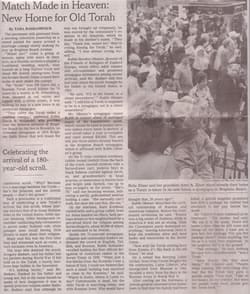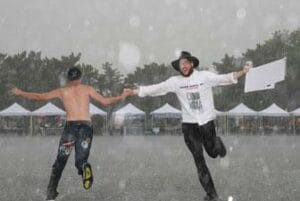By Tara Bahrampour
Click here to see pictures of the event
The pavement still glistened from a morning rainstorm yesterday as a crowd jostled for space around a marriage canopy slowly making its way up Brighton Beach Avenue.

”Mazel tov!” cried a group of women, some with tears in their eyes, as a Hasidic orchestra played a traditional wedding march, men danced on a long flatbed truck and about 600 Jewish immigrants from the former Soviet Union craned their necks to peer under the canopy.
The ”bride” was 180 years old, a Russian Torah scroll hidden for 70 years by a family in St. Petersburg. Now, encased in red velvet and topped with a silver crown, it was making its way to a new home in an American synagogue.
”They carry the Torah under a wedding canopy,” explained Rabbi David B. Hollander, who presides over the Hebrew Alliance of Brighton Beach by the Sea in Brooklyn, an Orthodox synagogue at 2915 Brighton Sixth Street that will house the czarist-era scroll. ”Why? Because it’s a marriage between the Torah — she’s the princess, and the Jewish people — that’s the groom.”
Such a procession is a traditional way of celebrating a new Torah’s arrival, but this scroll, whose journey mirrors that of so many Russian Jews to the United States, holds special meaning. Older immigrants remember conducting holy ceremonies in secret under Stalinist rule, while younger ones recall having little chance to learn about their religion.
Many said this was the first time they had witnessed such an event, a rare occasion even in America.
The man who donated the scroll, Gregory Bodnev, said his father lost his parents during World War II but held on to the Torah, a family heirloom kept hidden in the basement.
”It’s nothing heroic,” said Mr. Bodnev, flanked by his father and young son, but in the same breath he spoke of how dangerous it was to openly practice religion under Stalin. Mr. Bodnev said that although he was not brought up religiously, he was moved by the community’s response to his donation, which he made in his mother’s name. ”They say, ‘Thank you, mazel tov,’ they’re crying, kissing the Torah,” he said, adding, ”I was almost crying myself.”

Rabbi Hershel Okunov, director of the Friends of Refugees of Eastern Europe, which offers adult classes and circumcisions and promotes synagogue attendance among recent arrivals, said Mr. Bodnev told him last year about the scroll, brought by his father to the United States in 1993.
”He said, ‘It’s in the house, in a closet somewhere,’ ” Rabbi Okunov said. ”I told him a Torah is supposed to be in a synagogue, not in a closet somewhere.”
Mr. Okunov’s synagogue raised $6,000 to restore about 10 damaged pages of the handwritten scroll, which cannot be read in prayer services unless every letter is perfect. A new scroll takes a year to complete and costs around $30,000. This one will join three others already housed in the Brighton Beach synagogue, which is affiliated with Rabbi Okunov’s group.
As the D train rumbled overhead, rabbis tossed confetti from the back of the truck, excited children rode a horse-drawn cart, yeshiva boys in black fedoras carried lighted torches, and grandmothers in head scarves, or sometimes in festive hats and bright pink lipstick, ran up to kiss strangers on the street. ”She’s 79,” said one beaming woman, indicating a portly, gold-toothed matron holding a cane. ”She normally can’t walk, but once she saw this, she ran.”
On the sidelines, Hare Krishnas rattled bells and a group called Jews for Jesus handed out fliers, both perhaps drawn to this neighborhood by a perceived thirst for religion among Soviet emigres, about 20,000 of whom are estimated to be Jewish.
Inside the 73-year-old synagogue, religious and community leaders addressed the crowd in English, Yiddish, and Russian. Rabbi Hollander recalled leading the first official delegation of American rabbis to the Soviet Union in 1956. ”When just a few blocks from the Kremlin I saw a house of God, I could not believe that such a small building had survived so close to the Kremlin,” he said. ”Where is Stalin, where is Lenin today? Communism is dead, but the little Torah is marching today, and with Russian Jews. Who would have thought that, 20 years ago?”
Rabbi Okunov described the cyclical relationship of Russian and American Judaism. Before the Communist revolution, he said, ”Russia was a big center of Judaism, while in America it was not so strong. Then the Communist party destroyed everything,” leaving American Jews to keep the traditions alive and send books and emissaries to the Soviet Union.
”Now with the Torah coming here from Russia, it’s like back to the old times,” he said.
On a school bus ferrying Lubavitcher Jews from Crown Heights for the celebration, Lazar Liberov, who immigrated from Moscow in 1985, recalled a story from his days in the Russian Army in World War II.
After routing out the Germans, a Jewish general returned to his hometown to find that his family had been killed. A gentile neighbor presented him with a package his mother had entrusted to her just before her death.
Mr. Liberov’s eyes reddened as he continued: ”The mother had said, ‘My son is in the army. There will come a time when he will come and sweep out the Nazis. I want you to give him this package. For you this package doesn’t mean anything, but for us it is very, very important.’ So the neighbor hid it in the ground.”
”This package,” he said, dabbing his eyes with a handkerchief, ”was a Torah.”
”Such stories like that were many,” Mr. Liberov said. ”People, when running, left everything they had. But the Torah they gave to gentile people. They said, ‘Take all my money, all my jewelry. But when our people come back, please give the Torah back.’ ”




